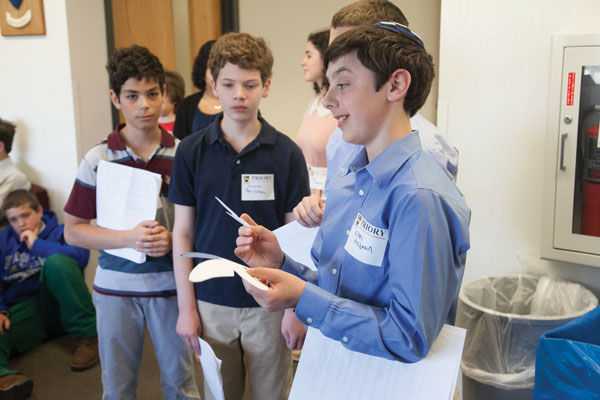With butterflies, students spread Holocaust lessons
Published April 27, 2016
As the school year winds to a close, a handful of seventh-graders at Saul Mirowitz Jewish Community School are working to help educate their peers in the community on the tragedy of the Holocaust.
“I’ve learned a lot about how the survivors have been scarred and how it was unforgettable for anyone who experienced it,” student Lucas Bernstein said. “We’d like to educate others so they also know how much this matters to so many people.”
Lucas, 13, is one of seven students from Limor Shacham’s Hebrew class at Mirowitz who have been touring area schools to tell others their age about the history of the Nazi genocide, particularly in regards to its youngest victims. As many as 1.5 million youngsters are believed to have perished during the Shoah.
During a visit to St. Louis Priory School earlier this month, 69 Catholic seventh-graders were able to speak to their Jewish visitors, listen to a brief presentation and then socialize in the cafeteria.
The Catholic students also were introduced to the centerpiece of the project: paper butterflies that they later would decorate as part of the initiative. This activity was inspired by “The Butterfly,” a poem by a young man who died in Auschwitz two years after writing it. It focuses on the poet’s having seen the last one of the colorful insects flutter out of his ghetto.
“Butterflies are a symbol of freedom and hope,” said Lucas, who recited the poem with his classmates. “These people who were in the ghettos and concentration camps wanted to be free, and they really needed hope to continue.”
Another inspiration for the project was a book read by the Mirowitz students about children whose teacher minimizes the Holocaust during history lessons and is corrected by her students.
Shacham said the book is important in helping to teach about moral courage.
“I wanted them to learn about non-Jewish people and what they think about the Holocaust, and to teach them that they can fight for their beliefs,” she said. “If you believe that something is not right, you can make people understand that.”
During a class, Shacham asked her students how they might help preserve memories of the Holocaust.
“They all wrote ‘by educating other people,’ ” she said. “After reading that answer, I sat with them and asked ‘How do you think we can educate people?’ ”
Soon, they arrived at the idea of touring other schools. Shacham said Priory was the second school they’d visited and the first outside the Jewish community. She said that more schools were requesting visits but she did not know how many would be made before the end of the school year in late May.
“We’re also going to synagogues for Hebrew schools and Sunday schools as well,” she said.
Priory students peppered their Mirowitz peers with questions during the visit. How long had they practiced for the project? Had they been to Israel? Could they speak phrases in Hebrew?
Bernie Kilcullen, a representative on the Priory student council, said he’d read books about the Holocaust but still learned a lot from the presentation about the scope of the tragedy.
“Everyone needs to understand that it shouldn’t happen,” he said.
Priory student Sami Haddad, 13, said he came away with a better understanding of the extent of the killing.
“I previously did not know that all those children were killed,” Sami said. “Because I am a child, I think it really impacted me. You think, ‘If I were in that situation, I could have been killed.’ ”
Mirowitz student Isaac Ohrenstein said the project involved months of reading and watching films about the Holocaust before they were ready to present lessons to others.
“We have learned how unforgettable and tragic this event was,” he said. “We’ve learned that many children died, and we’ve learned many stories of victims, unforgettable stories that have been quite emotional.”
Limor Shacham’s daughter Zoe said promoting tolerance was the key lesson of the project, which was named “The Butterfly Effect,” a term used in scientific theories and popular culture to describe how small changes can create big differences over time.
“We can educate others, and then those people would educate others, and it would go on and on like a ripple effect,” said Zoe, who added that the butterfly represents hope and freedom.
Patty Bloom, director of admissions and marketing at Mirowitz, said the learning tour is an example of how the school attempts to help youngsters develop their character.
“One of our goals for the students is not only that they grow intellectually, but that they grow as leaders and use everything they’ve learned to make the world better,” she said.
















